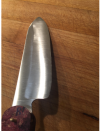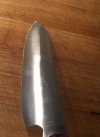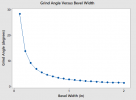- Joined
- Jun 3, 2019
- Messages
- 2,714
The knife pictured below (still in progress) is a first attempt to really pull together my individual learnings so far. A Santoku, AEBL, stock thickness is 0.095". My INTENT was to grind the secondary bevel to a width of 1.14" while maintaining a clean and consistent Shinogi along the length of the blade (including uniform distance from the upswept distal end of the edge), and maintaining reasonable symmetry between the sides. Per the trigonometry, this should give a secondary bevel angle of 2.4 degrees per side) Please reference the pictures below (grind has been taken to 320 grit (Trizact A65) and then scotchbright), thickness behind edge is ~0.01":


So ... the first picture shows a shinogi about what I was shooting for. However, things somehow fell apart on the second side. Shinogi is somewhat reasonable near the tip, but (not really clear in the photo) basically disappears down near the handle ... almost like the grind is flat-full-face at that location (i definitively did NOT go for that ... and I can not seem to correct it, short of using a surface grinder to re-flatten the spine side of the blade - and I do not have one of those! ). I am not sure what happened: my best guess is a slightly off-center grind relative to the edge centerline at that location creating a MUCH smaller than expected bevel angle on that side near the handle???
So here is my question: given the geometry involved (both blade thickness and width of grind to shinogi - with the resulting small 2.4 degree per side bevel angle) are my expectations of being able go create a "clean" shinogi in this case miss-placed??? I have gone back and reviewed about 3 years of postings in "whats happening in your shop" - and upon reflection, it seems most posted knives with this basic geometry have flat-full-grinds (which would not really suffer from this defect) - maybe that is for a reason????? Most of the postings that have a nice crisp shinogi are either thicker stock, or have a significantly less wide secondary bevel (for reference, while I was grinding, I had no trouble keeping a clean "shinogi" ... but started having trouble when the bevel width became somewhat wider than 1".....).
I have fair confidence that I could walk back to a 120grit ceramic belt and convert both sides of this blade to FFG - should I do so and not attempt this kind of feat again????
(I considered doing such while grinding, but did not want to give up on the objective - and so started to attach the handle. But I am now having second thoughts, and wondering if my "objective" was miss-placed. I am pretty sure I can go back to the grind with the handle partially fitted without damaging it......)


So ... the first picture shows a shinogi about what I was shooting for. However, things somehow fell apart on the second side. Shinogi is somewhat reasonable near the tip, but (not really clear in the photo) basically disappears down near the handle ... almost like the grind is flat-full-face at that location (i definitively did NOT go for that ... and I can not seem to correct it, short of using a surface grinder to re-flatten the spine side of the blade - and I do not have one of those! ). I am not sure what happened: my best guess is a slightly off-center grind relative to the edge centerline at that location creating a MUCH smaller than expected bevel angle on that side near the handle???
So here is my question: given the geometry involved (both blade thickness and width of grind to shinogi - with the resulting small 2.4 degree per side bevel angle) are my expectations of being able go create a "clean" shinogi in this case miss-placed??? I have gone back and reviewed about 3 years of postings in "whats happening in your shop" - and upon reflection, it seems most posted knives with this basic geometry have flat-full-grinds (which would not really suffer from this defect) - maybe that is for a reason????? Most of the postings that have a nice crisp shinogi are either thicker stock, or have a significantly less wide secondary bevel (for reference, while I was grinding, I had no trouble keeping a clean "shinogi" ... but started having trouble when the bevel width became somewhat wider than 1".....).
I have fair confidence that I could walk back to a 120grit ceramic belt and convert both sides of this blade to FFG - should I do so and not attempt this kind of feat again????
(I considered doing such while grinding, but did not want to give up on the objective - and so started to attach the handle. But I am now having second thoughts, and wondering if my "objective" was miss-placed. I am pretty sure I can go back to the grind with the handle partially fitted without damaging it......)



